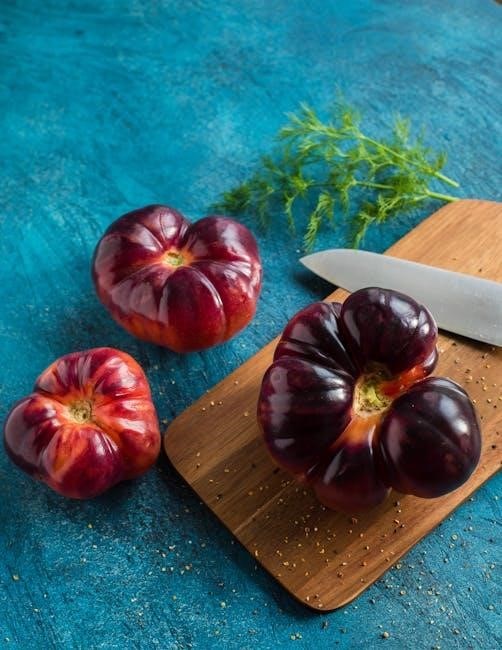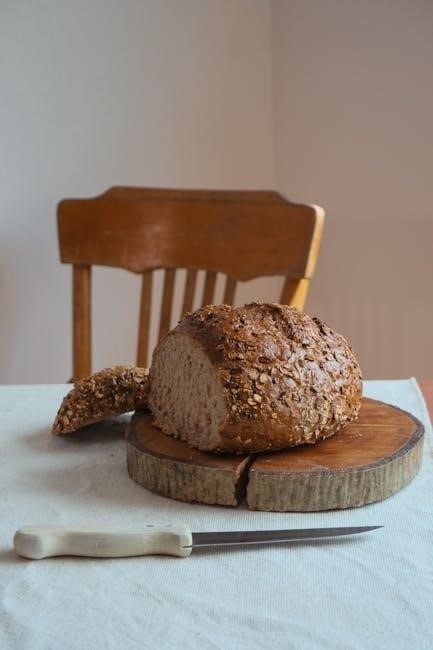Kitchen knives are essential tools for food preparation, offering precision, safety, and creativity in cooking. With various types and materials available, they cater to diverse culinary needs, ensuring efficiency and versatility in the kitchen.
Understanding the Importance of Kitchen Knives
Kitchen knives are indispensable tools in any kitchen, enhancing efficiency and precision in food preparation. Their versatility allows for various cutting techniques, ensuring safety and control. A good knife not only simplifies tasks but also elevates the quality of dishes, making it a crucial investment for home cooks and professional chefs alike. Properly maintained, they provide lasting durability and consistent performance, essential for creating memorable culinary experiences.

Types of Kitchen Knives
Kitchen knives vary in design and function, with common types including chef’s, paring, serrated utility, bread, and cleaver knives, each suited for specific cutting tasks and foods.
Chef’s Knife
The chef’s knife is the most versatile tool in the kitchen, ideal for chopping, slicing, and mincing ingredients. Its broad, straight-edge blade and balanced design make it perfect for precise cuts. Often called the workhorse of knives, it’s essential for both professional chefs and home cooks, offering unmatched control and efficiency in food preparation tasks.
Paring Knife
The paring knife is a small, versatile knife used for peeling, trimming, and coring fruits and vegetables. Its compact size allows for precise control, making it ideal for detailed tasks. Essential in both professional and home kitchens, it’s a must-have for handling smaller ingredients with accuracy and ease, ensuring clean and precise cuts every time.
Serrated Utility Knife
The serrated utility knife is a versatile tool designed for slicing meats, cheeses, and vegetables. Its serrated edge excels at cutting tough or fibrous materials, making it a workhorse in the kitchen. Ideal for tasks that require precision and grip, it’s a must-have for handling a variety of ingredients with ease and efficiency, ensuring clean and consistent cuts every time.
Bread Knife
The bread knife, with its long, serrated blade, excels at slicing bread, pastries, and delicate meats. Its sawing motion minimizes crumbs, making it ideal for crusty loaves and soft bread alike; A must-have for precise cuts, it ensures even portions and preserves texture, enhancing both presentation and flavor in various culinary preparations.
Cleaver
The cleaver, known for its robust, broad blade, is perfect for heavy-duty tasks like chopping bones, meat, and hard vegetables. Its thick spine delivers powerful blows, making it a versatile tool for both breaking down ingredients and crushing items like garlic. A cleaver’s strength lies in its ability to handle tough jobs, making it a must-have for serious home cooks and professionals alike.
Materials and Construction
Kitchen knives are crafted from stainless steel, carbon steel, or ceramic, each offering unique benefits in durability, sharpness, and maintenance. Construction methods vary, impacting performance and longevity.
Stainless Steel Knives
Stainless steel knives are renowned for their durability and resistance to rust, making them a practical choice for busy kitchens. They require minimal maintenance and are versatile for various cutting tasks, which is why they are a favorite among both professional chefs and home cooks. Their balance of performance and ease of care makes them a top selection.
Carbon Steel Knives
Carbon steel knives are prized for their sharpness and edge retention, making them a favorite among professionals. They require regular maintenance to prevent rust, as they are not stainless. Proper care involves keeping them dry and occasionally applying a thin layer of mineral oil. While they demand more attention, their exceptional performance in cutting tasks makes them worth the effort for serious cooks.
Ceramic Knives
Ceramic knives are sharp, durable, and rust-proof, making them ideal for precision cutting. Made from advanced materials like zirconia, they retain their edge well and are lightweight. However, they can chip if dropped or used on hard surfaces. Best for slicing fruits, vegetables, and boneless meats, ceramic knives are a great choice for cooks seeking low-maintenance, corrosion-resistant tools that deliver consistent performance.

Maintenance and Care
Regular sharpening, proper cleaning, and storage are crucial for maintaining knife performance. Avoid harsh chemicals and high heat to preserve edge quality and ensure longevity.
Sharpening Techniques
Sharpening is essential for maintaining knife efficiency. Use a whetstone or electric sharpener, starting with coarse grit for dull blades and finishing with fine grit for precision. Always sharpen at the correct angle, typically 20 degrees for straight-edge knives. Regular sharpening prevents dullness, ensuring clean cuts and safer use in the kitchen. Consistency is key to extending blade longevity.
Honing and Cleaning
Honing maintains a knife’s edge by realigning the blade with a steel. Clean knives with mild detergent and warm water, avoiding harsh chemicals. Dry thoroughly to prevent rust or dulling. Regular cleaning and honing ensure optimal performance, safety, and longevity of your knives, keeping them in prime condition for precise cutting tasks in the kitchen.

Handling and Safety
Proper grip and cutting techniques are crucial for safety. Always cut away from your body and keep fingers curled under. Use a stable cutting board and maintain a clean workspace to prevent accidents and ensure precise, controlled movements while handling knives.
Proper Grip and Cutting Techniques
A proper grip ensures control and safety. Hold the knife with a firm, pinch grip near the blade’s base for precision. Keep fingers curled and out of the blade’s path. Maintain a stable cutting board and cut away from your body. Use gentle, controlled motions for chopping, slicing, or dicing. Practice consistent techniques to enhance efficiency and minimize risks in the kitchen.
Safety Tips for Using Kitchen Knives
Always use a sharp knife, as dull blades are more hazardous. Cut away from your body and keep fingers curled under. Ensure the cutting board is stable and secure. Store knives in a block or on a magnetic strip, never loose. Avoid using knives near children. Keep knives dry and store them safely when not in use to prevent accidents.

Storage Solutions
Kitchen knives can be stored in blocks, on magnetic strips, or in protective cases. These options keep blades sharp, prevent accidents, and maintain kitchen organization and safety.
Knife Blocks and Holders
Kitchen knife blocks and holders are practical storage solutions, keeping blades sharp and within easy reach. Made from materials like wood or plastic, they protect knives from damage and add style to countertops. Placing them near food preparation areas enhances convenience while maintaining safety and organization in the kitchen.
Magnetic Strips and Cases
Magnetic strips and cases offer convenient and protective storage for kitchen knives. Magnetic strips mount easily on walls, keeping knives visible and accessible while saving counter space. Cases, often used for travel or storage, shield blades from damage and prevent accidents, ensuring knives remain sharp and secure in any setting.
Choosing the Right Knife
Selecting the right knife involves considering your cooking habits, the types of dishes you prepare, and personal preferences. Size, material, and comfort also play key roles in making the best choice for your kitchen needs.
Factors to Consider
When selecting a knife, consider blade material, edge type, handle comfort, and intended use. Stainless steel offers durability, while carbon steel provides sharpness. Handle materials vary, affecting grip and ergonomics. Ensure the knife aligns with your cooking style and the tasks it will perform, enhancing both efficiency and safety in the kitchen.
Budget and Personal Preference
Your budget and personal preferences play a crucial role in choosing a knife. Consider the cost of materials and craftsmanship, balancing quality with affordability. Personal preference includes handle style, blade length, and ergonomics. Investing in a knife that fits your needs ensures satisfaction and longevity, making it a worthwhile addition to your kitchen toolkit.
Advanced Topics
Japanese kitchen knives and specialty sets offer exceptional craftsmanship and diversity. Explore advanced styles, materials, and storage solutions for enhanced culinary experiences.
Japanese Kitchen Knives
Japanese kitchen knives are renowned for their exceptional craftsmanship and precision. Made from high-carbon steel, they offer superior sharpness and durability. Popular types include Gyuto (chef’s knife), Santoku (multipurpose), and Sashimi knives, each designed for specific tasks. Forged construction ensures a strong edge, while ergonomic handles enhance comfort. Proper care is essential to maintain their performance and aesthetic appeal.
Specialty Knives and Sets
Specialty knives cater to specific tasks, such as filleting fish or carving roasts. Knife sets offer convenience, bundling essential tools like chef’s knives, paring knives, and sharpening tools. High-quality sets often include ergonomic handles and storage solutions, enhancing both functionality and organization in the kitchen. Investing in a versatile set or specialized knife elevates culinary precision and efficiency for diverse cooking needs.
Kitchen knives are indispensable tools for culinary mastery. For further learning, explore tutorials, guides, and recommended reading on knife care and techniques to enhance your cooking experience.
Final Thoughts on Kitchen Knives
Kitchen knives are indispensable tools that elevate cooking skills and creativity; Choosing the right knife ensures efficiency, while proper care extends its lifespan. From chef’s knives to serrated utility knives, each type serves a unique purpose. Sharpening, honing, and safe handling are key to maintaining performance. Invest in quality, consider personal preferences, and explore resources like tutorials and guides for mastery. Happy cooking!
Recommended Reading and Tools
Explore books like “The Knife Guide” by renowned chefs for in-depth insights. Online resources such as video tutorials and sharpening guides are invaluable. Tools like sharpening stones, honing steels, and knife blocks ensure optimal maintenance. Websites offering detailed reviews and tutorials can enhance your knife skills. Invest in these resources to master knife selection, care, and techniques for a seamless culinary experience.